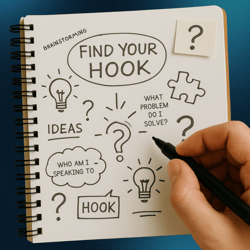Your elevator pitch is your personal commercial—just 30 to 60 seconds long—but if it sounds like everyone else’s, it won’t make an impact. That’s where a hook becomes essential: a sharp, compelling opening that grabs your listener’s attention and makes them want to know more.
Think of your pitch as a domino effect: the hook is the first tile. If it falls with strength and direction, everything else—your message, value, and ask—follows naturally. But if that first domino is too weak, the rest of your pitch never even gets moving.
A well-crafted hook isn’t just a flashy intro—it’s the ignition point for a memorable conversation.
Why a Hook Matters
1. You Have Less Than 8 Seconds
According to research shared by Asana, you have less than 8 seconds to capture someone’s attention—roughly the time it takes to check a notification or decide whether to keep scrolling. In a world filled with distractions, your pitch doesn’t get the luxury of a slow build.
A hook acts like a verbal jolt—it cuts through the noise, breaks expectations, and demands attention. If your opener doesn’t stand out, the rest of your pitch won’t land because your listener has already tuned out.
A great hook tells your listener this won’t be another bland introduction. Quick hooks set you up to build a compelling narrative from the first breath.
2. It Sets You Apart Instantly
Generic pitches begin with something like:
“Hi, I’m Jessica and I work in marketing.”
It’s safe—but also forgettable. It doesn’t spark curiosity or tell your listener why they should keep paying attention. In a networking setting or when trying to get referrals, sounding like everyone else is a fast track to being overlooked.
Now imagine opening with this instead:
“Most businesses have great ideas, but terrible storytelling. I help them fix that.”
This version does three powerful things in under 10 seconds:
- It frames a common problem your audience likely recognizes.
- It hints at your unique value without over-explaining.
- And it invites curiosity. How do you fix it? What kind of businesses do you help?
That’s the power of a hook. It turns your intro from a label into a launchpad.
3. It Creates a Natural Bridge to Your Value
A good hook isn’t a gimmick—it’s a setup for your story. The most effective hooks naturally flow into the rest of your pitch by introducing the problem you solve or the transformation you provide.
Think of your hook as the first domino. It should lead smoothly to who you are, what you do, and—most importantly—why your listener should care. A great hook doesn’t just “wow” for its own sake. It primes your audience for your value proposition.
Here’s an example of a full transition:
Hook: “You know how some websites feel like walking into a cluttered garage?”
Empathy: “That’s how your customers feel when your messaging isn’t clear.”
Resolution: “I help small businesses simplify their branding so people actually understand what they do.”
Ask: “Want to see what your homepage says in the first five seconds? Give me a call.”
By using the hook to frame a problem, you create an immediate path to your solution. It feels conversational, not canned—and that makes your pitch resonate more deeply.
How to Find Your Hook
Know Your Audience and Goal
Hooks aren’t one-size-fits-all. A great hook for a networking event might flop in a boardroom. Before crafting yours, clarify:
- Who you’re speaking to
- What outcome you want (connection, sale, feedback, etc.)
- What problem you solve for that audience
Choose a Hook Format That Fits
Some popular (and effective) hook types include:
- A thought-provoking question:
“Have you ever bought something and realized afterward you didn’t understand what it did?” - A surprising statistic:
“73% of small businesses fail because they can’t clearly communicate what they offer.” - A short, vivid story or metaphor:
“I used to pitch like I was reading a menu. Now I tell stories that sell.”
Explore which format aligns best with your tone and audience. Keep it short, punchy, and relevant.
Build on the Hook With a Structure
Once you’ve captured attention, don’t leave your audience hanging. Use your hook to lead into a proven pitch framework like HERA (Humanize/Hook – Empathy – Resolution – Ask). You can learn more about using HERA in our blog post The Art of the Elevator Pitch.
Wrapping Up
Your elevator pitch is too valuable to waste on generic openers. Start strong, spark interest, and lead with intention. A hook is your pitch’s ignition—it gets things moving. And when you pair a great hook with a strong structure, you don’t just get heard—you get remembered.
Additional Resources
If you’d like to dive deeper into crafting great hooks and memorable pitches, check out:
External Guides:
-
Asana – 25 Elevator Pitch Examples: Highlights how different hooks work for business, job interviews, and networking.
-
Pitcherific – How to Craft a Captivating Hook: Focuses on how to grab audience attention and test hook formats in the wild.
-
Crowdspring – Why You Need a Strong Elevator Pitch: Offers guidance on storytelling, clarity, and integrating hooks into a short pitch.
Related Articles on the Pitch59 Blog:
- The Art of the Elevator Pitch: Using HERA: Learn how to build a full pitch around your hook using the HERA framework (Hook – Empathy – Resolution – Ask).
- Elevator Pitch vs. Sales Pitch: Understand the key differences so your hook fits the right context.
- Connecting Through Stories: Explore how stories create emotional resonance and make your hook (and pitch) more memorable.
